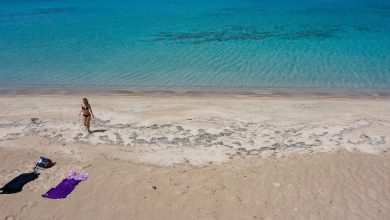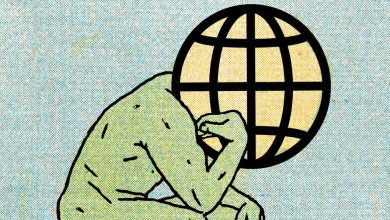As Monkeypox Spread in New York, 300,000 Vaccine Doses Sat in Denmark

On the Thursday before Pride Weekend last month, hundreds of men dropped what they were doing and raced to a city-run health clinic in Manhattan. Finally, more than a month after monkeypox appeared in New York City, a vaccine was being made available to sexually active gay and bisexual men, among whom the virus was rapidly spreading.
But there was a catch: There were only 1,000 doses available. Within two hours, the only clinic offering the shots began turning people away.
At that same moment, some 300,000 doses of a ready-to-use vaccine owned by the United States sat in a facility in Denmark. American officials had waited weeks as the virus spread in New York and beyond before deciding to ship those doses to the United States.
Even then, there was little apparent urgency: The doses were flown piecemeal, arriving over the span of two weeks. Many didn’t arrive until July, more than six weeks after the first case was identified in New York City.
By holding back the doses, an early opportunity to contain or slow the largest monkeypox outbreak in the country appears to have slipped by. On Saturday, the World Health Organization declared monkeypox a global health emergency. At least 16,000 cases have been reported around the world, with about 3,000 in the United States. Infections in New York City make up nearly a third of the national case count.
Limited testing means those numbers are likely a significant undercount.
The federal response to monkeypox, including the limited testing capacity, has echoes of how public health authorities initially mismanaged Covid-19.
With monkeypox, however, the federal government had a powerful tool to slow the spread from the start: an effective vaccine.
Yet the government was slow to deploy the vaccine, which was originally developed and stockpiled for use against smallpox, activists say.
“The U.S. government intentionally de-prioritized gay men’s health in the midst of an out-of-control outbreak because of a potential bioterrorist threat that does not currently exist,” said James Krellenstein, a Brooklyn-based gay health activist, who has been urging health officials to make the vaccine more widely available since June.
The federal official in charge of the agency that manages the United States’ supply, Gary Disbrow, said the government was “moving very quickly because we take this very seriously.”
“We thought it prudent to get as many doses as we had available over here, fully understanding that if the doses are not used there would be a potential impact on smallpox,” he added. “We moved very quickly based on the number of cases we saw.”
Called Jynneos, the vaccine is effective against both smallpox, which generally has a 30 percent fatality rate, and monkeypox, which can be severe but has a far lower fatality rate.
When monkeypox was first detected in the United States in mid-May, there were some 2,400 doses on U.S. soil, in the federal government’s strategic national stockpile, used mainly to protect lab workers and Centers for Disease Control and Prevention personnel engaged in research, officials said.
What to Know About the Monkeypox Virus
What is monkeypox? Monkeypox is a virus similar to smallpox, but symptoms are less severe. It was discovered in 1958, after outbreaks occurred in monkeys kept for research. The virus was primarily found in parts of Central and West Africa, but in recent weeks it has spread to dozens of countries and infected tens of thousands of people, overwhelmingly men who have sex with men. On July 23, the World Health Organization declared monkeypox a global health emergency.
What are the symptoms? People who get sick commonly experience a fever, headache, back and muscle aches, swollen lymph nodes, and exhaustion. A few days after getting a fever, most people also develop a rash that starts with flat red marks that become raised and filled with pus. On average, symptoms appear within six to 13 days of exposure, but can take up to three weeks.
How infectious is it? The virus, which has a low fatality rate, is spread by touching infected items like clothing and bedding, or by the respiratory droplets produced by sneezing or coughing, according to the World Health Organization.
I fear I might have monkeypox. What should I do? There is no way to test for monkeypox if you have only flulike symptoms. But if you start to notice red lesions, you should contact an urgent care center or your primary care physician, who can order a monkeypox test. Isolate at home as soon as you develop symptoms, and wear high-quality masks if you must come in contact with others for medical care.
What is the treatment for monkeypox? If you get sick, the treatment for monkeypox generally involves symptom management. Tecovirimat, an antiviral drug also known as TPOXX, occasionally can be used for severe cases. The Jynneos vaccine, which protects against smallpox and monkeypox, can also help reduce symptoms, even if taken after exposure.
Can I get the vaccine? Two vaccines originally developed for smallpox can help prevent monkeypox infections. Jynneos is the most commonly used, and consists of two doses given four weeks apart. Because the supply is limited, it has mostly been offered to health care workers and people who have had a confirmed or suspected monkeypox exposure. A few states, including New York, have also made vaccines available among higher-risk populations, including men who have sex with men.
The United States also owned well over a million Jynneos doses in vials ready for use — and enough vaccine for millions of more doses that had yet to be filled into vials — in Denmark, where the producer of the vaccine, Bavarian Nordic, is headquartered.
Much of that supply was tied up in bureaucratic red tape because the Food and Drug Administration had yet to inspect and certify a new facility outside Copenhagen where the company now fills the vaccine into vials — an issue that has yet to be fully resolved.
But there were 372,000 doses owned by the United States that were ready to go. These doses, stored at the company’s headquarters, had been filled into vials earlier, at a different facility with the necessary F.D.A. approval.
Rather than quickly transfer those doses back to the United States and begin administering them, however, the federal government adopted a wait-and-see attitude. In the first few weeks after monkeypox was detected in the United States, the government requested only 72,000 of the 372,000 doses.
The job of managing the country’s supply of Jynneos falls largely to the Biomedical Advanced Research and Development Authority, or BARDA, a federal agency that develops and procures drugs and vaccines to protect against pandemics, bioterrorism and other hazards. The authority supported development of the vaccine following the terrorist attacks of Sept. 11, 2001, as the federal government worried about the use of weaponized smallpox.
One reason that federal officials were reluctant to order all available doses early on involved cold storage and shelf life. The storage facilities in America where the doses would be kept weren’t as cold as the Denmark facility, said Dr. Disbrow, a senior official at the Department of Health and Human Services who runs BARDA.
“So if all the doses were not necessary for the outbreak,” he said, “their shelf life would be dramatically shortened.”
Joseph Osmundson, a microbiologist and queer activist, said that the monkeypox outbreak may not have been the emergency that the federal government had prepared for — weaponized smallpox — “but this is an emergency nevertheless.”
“There is no excuse for this level of bureaucratic inaction,” he said.
The first monkeypox case to be detected in the United States this year was identified in Massachusetts on May 18. New York City identified a case the next day. On May 20, BARDA requested that Bavarian Nordic send over 36,000 doses, a spokeswoman for the agency said. They arrived five days later.
On May 27, BARDA requested another 36,000 doses, which arrived two weeks later, Dr. Disbrow said. By then, 16 cases of monkeypox had been detected in New York City, along with cases in 14 other states and the District of Columbia.
Dr. Disbrow said that only so many doses could be transported per flight. In an email, a spokesman for Bavarian Nordic explained that each large order required some lead time. The company had to first receive a container, known as a cocoon, from the shippers and then “freeze them to temperature for five days” before packing it with vaccine.
As of June 10, the federal government had distributed just a few thousand doses of monkeypox vaccines to states, officials said in a call that day with reporters. A senior Health and Human Services official, Dawn O’Connell, said the United States would receive 300,000 doses of Jynneos “over the next several weeks.”
Except, the U.S. government hadn’t yet requested them. “That order came in late June,” a Bavarian Nordic spokesman said.
Dr. Disbrow, the BARDA director, gave a similar timeline in an interview, although a spokeswoman for the agency subsequently said the government asked for those doses earlier, on June 14.
By all accounts, the first shipments of the remaining 300,000 doses did not begin arriving until June 29 or 30, several days after the New York City Pride March and related festivities, and they arrived in several shipments, Dr. Disbrow said.
But many of the doses did not arrive until July. Bavarian Nordic said some were delayed in part because they had to be driven from Copenhagen to Germany, because airline pilots were on strike at SAS, the Scandinavian airline.
Asked about the delays, the BARDA spokeswoman, Elleen Kane, said that if one counted only “business days” the time lag was shorter.
Mr. Krellenstein, the activist who leads a group, PrEP4ALL, which works to increase access to daily medication that prevents H.I.V. infection, was one of the first to be vaccinated during New York City’s first window, on June 23. But he received a deluge of text messages from friends who said they’d missed out.
That evening, Mr. Krellenstein called a health activist he knew in Boston: “We said, ‘Oh, my God, the doses aren’t coming. What’s going on?’”
He said he was stunned to learn that most of the doses were stuck in limbo in Denmark awaiting the F.D.A. facility inspection.
Along with several H.I.V./AIDS activists, including some from the group ACT UP, Mr. Krellenstein began demanding meetings with White House and federal health officials to learn more about the hold up.
“Those doses likely would have been sufficient to stem the initial outbreak, if they had been mobilized and administered in the U.S.,” Mr. Krellenstein wrote in an email to several Biden administration officials in mid-July.
A spokeswoman for Health and Human Services, which oversees BARDA, responded by suggesting that more doses hadn’t been needed earlier, noting that initially the C.D.C. had only endorsed the vaccine for a limited group: known contacts of monkeypox patients.
Though New York City had by June 23 decided to offer the vaccine more broadly — to all men who had recently had sex with multiple or anonymous male sexual partners — the federal government did not endorse that move until June 28.
By early July, it was clear that the spread of monkeypox was accelerating among men who have sex with men in New York City.
Sergio Rodriguez, 39, a transgender queer man who lives in the East Village, said he tried to get vaccinated before Pride Weekend, but was turned away. He hooked up with a few people, and about a week later, began to feel abdominal pain, swollen lymph nodes and body aches. Lesions then spread across his body, and some made it excruciating to urinate.
“I’ve actively been trying to do things to support myself because I knew that I would be at high risk,” he said.
“It’s really frustrating,” he added, that the government “was not set up to adequately meet the demand.”
The situation in New York City had been especially frustrating. By mid-July, there were already more than 200 known cases in New York, but the city had received only 7,000 doses.
When the city received an additional 14,500 doses a few days later, the available vaccination slots were taken within seven minutes of being posted online.
Lawrence Gostin, a former C.D.C. adviser who directs the O’Neill Institute for National and Global Health Law at Georgetown University, said it was clear based on recent conversations he had with White House officials that they were searching for a czar-like figure to run the monkeypox response, in what would be an acknowledgment of the need for more sweeping action by the federal government.
Several administration officials confirmed that such a search was underway. Raj Panjabi, the White House director of pandemic preparedness, has so far overseen monkeypox response efforts.
One White House official familiar with the administration’s response said that while it was also considering declaring a public health emergency, there was still an active discussion about what powers such a declaration might provide. Mr. Gostin said officials were working to determine how such a move could potentially free up funds for research, vaccines and treatments.
The flow of vaccine doses to New York has begun to increase; the city has now received 46,000 of them. But online appointments are still snapped up within minutes. And by now, monkeypox has spread widely enough in New York City that epidemiologists doubt it can be contained anytime soon.
Noah Weiland and Sharon LaFraniere contributed reporting from Washington.



